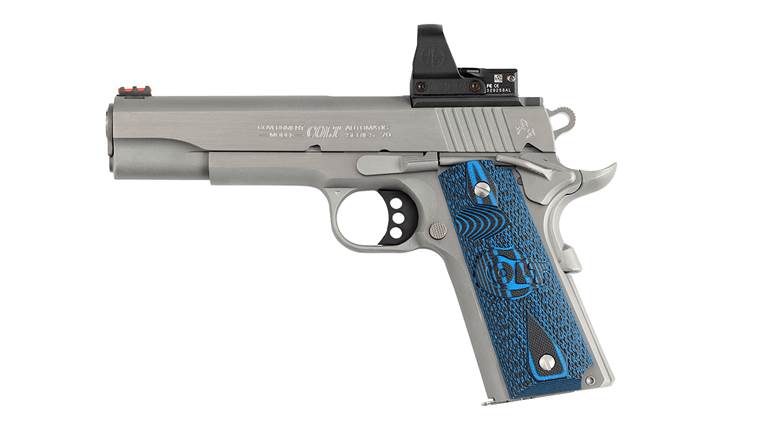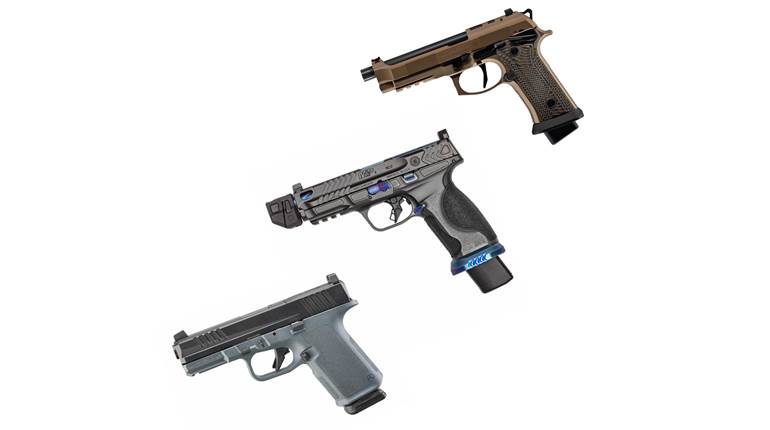
Internet foolishness has forced a very busy man with a big job, Colt’s Mfg. Co. President and CEO Dennis Veilleux, to step away from making sure guns are produced at the East Hartford, Conn., factory and, instead, focus on the chatroom perception that, somehow, today’s Colt’s is against the consumer sale of AR-15s. 
That is patently ludicrous as this is a company that can make 1,000 rifles a day on a good day of production, whether they be for law enforcement, the U.S. government, friendly foreign nations or the semi-automatic-only guns it has made since 1963. No one is more for the lawful commercial sale of the rifles they make than the people who make them at Colt’s—but it’s not up to them.
This began when an e-mail from distributor RSR hit the web, and started yet another Colt’s Chicken Little kerfuffle. “We have just been notified by Colt Firearms that they [sic] will be discontinuing production of all long guns to focus on regaining military contracts.”
“There have been numerous articles recently published about Colt’s participation in the commercial rifle market,” wrote Veilleux in a Sept. 19 release. “Some of these articles have incorrectly stated or implied that Colt is not committed to the consumer market. We want to assure you that Colt is committed to the Second Amendment, highly values its customers and continues to manufacture the world’s finest quality firearms for the consumer market.”
I know Dennis Veilleux and Senior Vice President for Commercial Business Paul Spitale personally. I’ve spent a lot of time with Spitale since he came to Colt’s, and I can assure you that he is not an anti-gunner in sheep‘s clothing. He gave up a lucrative job in the consumer electronics industry because of his love for guns—Colts in particular. These are not men with a hidden agenda; they are trying to keep one of the oldest names in firearms afloat and healthy.
Sensationalists postings partially based upon the very solid reporting done by Shooting Illustrated’s Evan Brune, “The Truth About AR-15 Production,” have somehow led to a backlash against Colt’s for the company’s plan to “cease AR-15 production for the civilian market.” Read the actual story before you go off half-cocked.
“We listen to our customers,” Spitale told Brune. “The whole basis for our reorganization was consumer feedback.” I was informed that there was several months’ supply of the guns in distribution already. (Although the sensationalism may now have caused it to evaporate). Several months’ supply? That, in detective and business circles, is known as a clue. If you have several months production in the pipeline that no one is actively purchasing, why would you put several months more production into the same pipeline? If your drain is clogged and your sump pump broken, don’t turn on the garden hose and shove it in the drain.
Unlike quite a few other companies, Colt really has only one way of making rifles—a production line that can manufacture all of its long-gun products. Aside from the heavily restricted fully-automatic components used for the M4, when it comes the upper, most parts, the assembly and the processes except for some testing between semi-automatic-only guns intended for consumers and military guns with selective-fire capability, they run pretty much through the same processes on the factory floor.
And that means that the cost—to Colt—is quite similar, regardless of which model it is. Colt probably cannot produce just an upper for what some companies are selling complete rifles for these days. If you cannot be competitive on price, you are trading just on your name brand and reputation. It would appear that the Colt name is not worth sometimes up to $500 difference in price at the gun store counter to most consumers.
“The fact of the matter is that over the last few years, the market for modern sporting rifles has experienced significant excess manufacturing capacity," continued Veilleux. “Given this level of manufacturing capacity, we believe there is adequate supply for modern sporting rifles for the foreseeable future.”
The folks at FN America face a very similar problem—it can make a lot of rifles. While FN’s U.S. factory is not a union shop like Colt—and not in Connecticut, either—the cost of its semi-automatic-only variants of the rifles produced by the firm in South Carolina are simply higher than those from many other makers. The decision to sell its guns with the external appearance and rail systems of the military guns as part of the semi-automatic-only “Military Collector” series was a good one. This way, FN could charge enough for the guns to actually make a profit on them. In case you need a reminder, profit remains the reason why people make things. They make them to sell. At a profit. The overall sales volume is diminished, but making lots of guns you can’t sell is a bad idea compared to making fewer guns that you can actually sell. Otherwise a company might as well use them as rebar at the next plant expansion.
“On the other hand, our warfighters and law enforcement personnel continue to demand Colt rifles and we are fortunate enough to have been awarded significant military and law enforcement contracts,” wrote Veilleux. “Currently, these high-volume contracts are absorbing all of Colt’s manufacturing capacity for rifles.” Read between the lines on what Veilleux had to say next. “Colt’s commitment to the consumer markets, however, is unwavering. We continue to expand our network of dealers across the country and to supply them with expanding lines of the finest quality 1911s and revolvers.” The M1911 business and the revolver business are indeed expanding for Colt—and there are new introductions coming in both areas.

Remember the “customer feedback” mentioned by Spitale? It comes in many forms. Much of it is online, but some very direct feedback comes at the gun store counter. When it comes to the latter, consumers have been voting with their wallets to not spend the extra money that Colt necessarily has to charge for a 6920. If there is insufficient demand for the rifles you can make, but you can’t meet demand for M1911s, Cobras and King Cobras, as a man entrusted with a business, what would you make more of if you can? 
Turns out it is not all Colt rifles that are suspended, either. I reached out to Spitale because I was very concerned about Colt’s “AR-15 Military Classics” series. They made a very special XM177E2 for my dear friend and hero Major John L. Plaster, USAR (Ret.), replicating the gun and serial number he carried as a Special Forces soldier in Vietnam—in semi-automatic only, of course. Spitale assures me that those guns, although pricey, are still available. And they have no plans to discontinue them.
Major John L. Plaster (center), flanked by U.S. Ordnance owner Curtis DeBord and Curt Wolf, owner of U.S. Armament, who manufacture the AR-15 Military Classics Series in partnership with Colt. These guns are still offered, contrary to widespread reporting.
“At the end of the day, we believe it is good sense to follow consumer demand and to adjust as market dynamics change,” Veilleux concluded.” Colt has been a stout supporter of the Second Amendment for over 180 years, remains so, and will continue to provide its customers with the finest quality firearms in the world.” I have been a fierce critic of Colt when its management does something wrong in the past or more recently, and that is simply not the case here. I don’t doubt his word, and neither should you.
Additional Reading:
The Keefe Report: Colt AR-15
The Case for the 20" Barreled AR-15 Rifle
Welcome to the Snark Tank: I Don't Actually Hate Colts
NRA Gun of the Week: Colt LE901 16s
Quick-Change Solution: Colt LE901s
The Curious Case of Colt





































